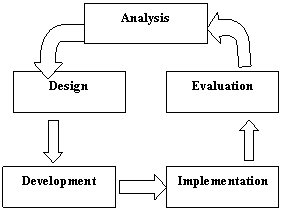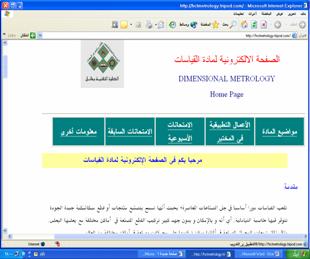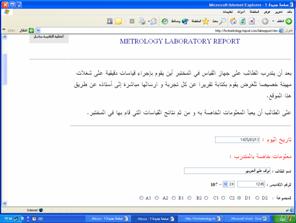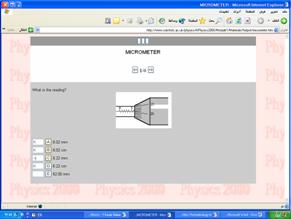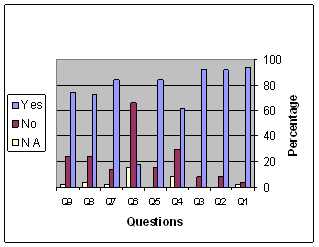e-Learning in Technical Education and Vocational Training: From Concepts to Practice
Mohamed AICHOUNI Mohammad Othman AL-NAIS
PhD, Assistant Professor EdD, Assistant Professor
Hail College of Technology. Hail College of Technology
Email : m_aichouni@yahoo.co.uk Email : dr_alnais@hotmail.com
Paper Presented at : The 3rd Saudi Technical Conference and Exhibition, Riyadh, Kingdom of Saudi Arabia
28 Shawal – 4 Dhul-qaada 1425 H , 11- 15 December 2004
have a look at the PowerPoint presentation (In Arabic)
2 - Why use ICT in
Education of Metrology?
4 – Development
of a web-Based Course on Metrology
5 – Assessment of the
web-based course
6 - Conclusions drawn and
future plans
Since the times of Euclid's, knowledge has been delivered using the
face-to-face interaction between the learner and his teacher. It is
universally accepted that this approach is the best way for education and
training. However, with the advent of the Information and Communication
Technologies (mainly the World Wide Web) it became possible to enhance
further the methods we are using to teach our students. In the present
paper, Web based education approach is used as a learning tool to
demonstrate Metrology concepts and dimensional measurement techniques for
technical students. An electronic course has been developed as an e-Learning
package available on the internet for student enrolled at the first year
mechanical technology diploma.
KEY WORDS: e-Learning, Web-based Education, Metrology, Quality.
1 - INTRODUCTION
Information and Communication Technologies (ICT) open a completely
new world for the use of the latest technology progresses in education and
training. Hardware and software developments enable obtaining of a good
result in relatively favorable costs. Proper attention must be paid to such
possibilities to encourage teachers and students to take the advantages
offered by ICT. It does not definitely mean that the educational classicism
is forgotten. Information and Communication Technologies just bring new ways
how to transform scientific information in a new form and in an adequate
manner to students and learners.
Developed countries such as USA, Canada, Australia and the European
Union have adopted policies concerning the use of ICT services (Computer
Networks, Internet, www, multimedia, java etc..) by educational and training
institutions, enterprises and individuals. Political summits (Stockholm,
March 2001) have stressed the importance of ICT for the creation of a so
called society of knowledge, for higher quality of education and
subsequently for the economical growth; for removing barriers of employment
among individual states, etc. In particular, the training policy vision
includes:
·
Development of human skills necessary for
living and work in the information society;
·
The use of modern information and
communication technologies in training;
·
The diversity of training possibilities
(tutorials, open universities, and distance learning);
·
Contribution to higher quality education;
·
Improvement of the access to education for all
people including disabled people, women and minorities .
It has been shown by international educators that Information and
Communication Technologies (ICT) offer the following innovative features to
education and training:
·
High illustrative ness,
·
Knowledge concentration in one product which
can be directly used for training,
·
High flexibility and adaptability in
preparation of training courses for individual target groups with different
training needs,
·
Facilitated access to the training,
·
Use in different types and levels of the
education.
The above-mentioned points, concerning use of ICT in educational process,
stress increased efficiency of the training that has a great
economical impact.
2 - WHY USE ICT IN
EDUCATION OF METROLOGY ?
Metrology is the science of measurements associated with the evaluation of
its uncertainty. Metrology and measurement have a key position in the areas
of science, research, industrial production, product quality testing and
certification. While metrology is seen to be a research science for highly
specialized experts, its results together with the appropriate measurement
equipment are widely used in the every aspects of our daily life. Modern
industries rely heavily on measurements and metrology. It is estimated that
the costs of measurements represent up to 10-15% of the production costs. In
Europe of today what is measured and weighted costs about 6% of the combined
gross national product (Halaj et al. 2003). Increasing precision of
measurements, more sophisticated methods and means, continuing research as
well as considerable amount of newly adopted ISO normative standards lay
high requirements on the qualification and skills of persons working in this
area. Adequate knowledge in metrology and measurement is rather necessary
for industrial technicians, engineers and also managers in almost all
engineering fields (Mechanical, Automotive, Petrochemical, Electrical,
Electronics, Defense, Health, Trade, etc..).
Within highly competitive market, modern companies should consider metrology
and measurement in their technological decisions and innovation policies.
This has resulted in an increased demand for training in the area of
metrology and measurement. With the advent of the ISO 17025 (formerly ISO
Guide 25) and the ISO 9000 Quality Assurance series, and through a DACUM
curriculum analysis, Bagley (2000) showed that the need for metrologists is
continuing to rise in order to support the strong demand in both the private
and the public industrial and commercial sectors.
The potential of the traditional approaches to vocational training in
metrology and measurement has reached its performance limit and can not
fully satisfy the actual and future requirements (Hofmann and Linss (2003)).
The traditional vocational training system in the area of measurements and
metrology provides face-to-face training courses consisting of lectures,
exercises and laboratory trainings. The advance in Information and
Communication Technologies in the form of the World Wide Web, HTML, Java
programming, Microsoft Office, Scientific Computing Environments and
Multimedia have been shown to offer real opportunities for enhancing the
quality of engineering education and training. Web-based learning will
create very good conditions for the training of regular college students,
for disabled people, and of course, ensures equal chances to women for
vocational training and technical education.
3 - What is e-Learning?
The main difficulty in attempting to define e-Learning is that it is
relatively new and still evolving. A standard way of writing ‘e-Learning’
has not yet been established. It is still written in different ways:
“elearning, e-Learning, ELearning, E-Learning”. “e-learning (electronic
learning) refers to training, education, coaching, and information that is
delivered digitally. e-Learning may be synchronous, meaning that learners
and instructors are interacting in real time or not, in which case the term
asynchronous applies. e-Learning is normally delivered through a network via
the Internet, but it may also be delivered by CD-ROM, satellite, and even
supported by the telephone.” (Broadbent Brooke, 2002).
The true power of e-Learning is likely to be found in its potential to
provide the right information to the right people at the right times and
places.
e-Learning is being presented in the marketplace as the next evolution of
the training and education industry and the next phase in the digital
revolution. Having established what the literature has to say about
e-Learning, it is appropriate to identify the benefits of using e-Learning
to industrial companies and employees:
·
Wide Availability and Accessibility
·
Convenience
·
Improved Retention
·
Instant Feedback
·
Accommodation of Different Learning Styles
and Multimedia formats
·
Hands on Training
·
Collaboration
·
Standardized Course Delivery
·
Information Resource
·
Learner Control and Ownership
·
Lower Costs
The use of technology to acquire learning and to deliver training
has been with us since early sixties and it has been developing since then
with the advent of this technology (Figure 1). In the open literature many
forms (and colors!)
of e-Learning have been presented during the last decade as shown in
figure2. As proposed by Broadbent (2002) a common structure of all
e-Learning forms is based on four major components. These are :
·
The Learner;
·
The Content;
·
The Instruction and;
·
The Technology.
The structure is best presented as a quality triangle which reflects the
fact that the objective of this approach is to improve and to enhance the
learning process quality. The learner is at the middle of the structure and
the other component have to be in line with what he can handle.
Figure 2 – Basic Structure of e-Learning and its Types (Braodbent,
2002)
4 – Development
of a web-Based Course on Metrology:
Based on the above analysis of e-Learning components, a group of educators
at the Mechanical Technology Department launched a project to develop
web-based training programs. The aim was to develop and disseminate
multimedia training packages for technical education and vocational
training in the areas of Metrology and
Quality Control (Aichouni,2004),
AutoCAD and
Material Testing (Bedri,2004). The purpose of these
web-based packages is to improve the quality and efficiency of the
vocational training in mechanical technology, to facilitate the access to
this training as well as to contribute to wider use of Information and
Communication Technologies in Technical Education and Vocational Training in
accordance with the general policy adopted by the GOTEVOT.
The e-Learning cycle shown in figure 3, follows the ADDIE model, which is
adopted from the Statistical Process Control Approach used in process
quality improvements. ADDIE stands for Analysis, Design, Development,
Implementation and Evaluation. During the project these important phases
have been considered with a great care and careful consideration.
Figure 3 – e-Learning Life Cycle
The Metrology web-based course which is described in this paper, has been
prepared in Arabic language; It consists mainly of multimedia courseware
including theoretical lectures, exercises, tests, laboratory reports,
and supporting modules, all in hypertext form, supported by graphical
illustrations (including full color figures, computer animations, video
sequences). Table 1 summarizes the content of the web-based course which is
adopted from the standardized curriculum designed by the GOTEVOT. Figure 4,
shows the main page of the course where the student can move to any subject
(Different measurement techniques, laboratory reports, past exams, etc..)
through the hyperlinks available. Interactivity has been added to the web
course through different techniques:
·
Web links to other training sites (mainly to
enhance his training on the reading of micrometers and Vernier Calipers
(Figure 5-a))
·
Continuous exams posted to the web by the
teacher: The student has to work out these exams as home work and to submit
it to his teacher within the week.
·
Laboratory reports to be prepared by the
student after each training session according to a pre-designed model
available on the web (figure 5-b).
·
An email address has been provided to students
to contact their teacher and ask any question or make any comment about the
lectures or the training laboratory session.
Table 1 – Metrology Web-Based Course Content
Working package
Module
1
General introduction
1
Basics of metrology and measurement
2
International System of Units
3
Metrology in the Holly Koran
4
Dimensional measuring principles
2
Dimensional Measurements
5
Steal Rulers
5
Vernier Calipers
6
Micrometers
7
Gage blocks
3
Angular Measurements
8
Angular Measurements Techniques
4
Form and shape metrology
9
Form and shape metrology
5
Measurement uncertainty
10
Uncertainty in measurement
11
Measurement process control
6
Legal Metrology and Organizations
12
National and International Metrology organizations (ISO, OIML,
SASO, etc…)
13
Accreditation and Certification
7
Introduction to Quality Control
14
Introduction to Quality Control
5 – Assessment of the
web-based course:
The web-based course developed has been used as a supplement to the regular
classroom for the second semester of the academic year 1424/1425 Hejrit. In
order to make an evaluation of this experience within our technical college
conditions, a survey has been designed and given to enrolled students
attending the metrology course. The survey which is designed and prepared in
Arabic language is shown in appendix A. The number of students who answered
the survey was 50 out of 57 students enrolled on the course. Typical results
are summarized in table 2 and figure 6. From this survey, it is clear that
the e-Learning approach is well accepted by the technical college students
though some difficulties and barriers which still exist between the student
ant the IC Technologies. The great majority of the students agreed that most
of the aspects related to the design, development, implementation and
delivery of the electronic course via the internet are good. Most
importantly is that the tested students showed a general acceptance to learn
through this new approach while some of our colleagues educators and
trainers show a resistance to change from the traditional method to the new
method of teaching and training (e-Learning).
This web-based course developed is believed to create very good conditions
for learners mainly students attending regular classroom and to senior
engineers and technicians attending continuing training programs at the
department; Also for the training of disabled people, and of course can
ensure equal chances of women for technical education and vocational
training as well.
Figure 4 – The web-based Metrology Course Home Page
http://hctmetrology.tripod.com
Figure 5 – Interactivity enhancement modules at the web-based metrology
course
Table 2 – Survey Evaluation Results
Question
Answer
No Answer
Yes
No
Q1 The student
visited the metrology web page 94 % 04 % 02 %
Q2 The page
content is useful to the degree prepared 92 % 08 % 00 %
Q3 The
language used in the web page is correct 92 % 08 % 00 %
Q4 The
access to the web page is easy 62 % 30 % 08 %
Q5
Navigation through the different modules of the page is easy. 84 % 16 % 00 %
Q6 The student
visited the web links provided on the
page 18 % 66 % 16 %
Q7 The
page is important and worth the time you spend
reading it. 84 % 14 % 02 %
Q8 The
e-Learning approach is suitable to mechanical
technology education and training 72 % 24 % 04 %
Q9 This
approach should be generalized to other courses in the syllabus.
74 % 24 % 02 %
Figure 6 – Web-based course evaluation results
6 - Conclusions drawn and future
plans:
The implementation of e-Learning concepts to Technical Education and Vocational
Training allowed to develop a web-based course on Metrology designed to first
year mechanical technology students. The web-based course has been hosted on the
net and is available for students, trainees, and any one wishing to get trained
in this specific area of technology. The e-course which is hosted on (http://hctmetrology.tripod.com)
can be freely accessed by the technical and the academic populations. Comments
and remarks concerning, the content, the design and the techniques used to
deliver this training, coming from the readers would be most welcome.
If the e-Learning approach is to be useful and successful in technical education
and vocational training, it needs to reach a wide audience that will provide a
large user community. Through large user base, sufficient comments can be
expected which would lead to a better improvement of web-based courses.
There are issues of awareness and promotion of this site so it will reach the
widest possible technical students community, working technicians and engineers
in Saudi Arabia, G.E.C. countries and the Arab world. An international dimension
can be reached if English and French mirrors of the site are added.
7 - References:
[1] M. Halaj, P. Gabko, E. Kurekova1 and R. Pale, 2003, `Project for the
modern educational tool in measurement and metrology`, Measurement Science
Review, Volume 3, Section 1, pp. 23-26.
[2] J. L. Bagley, 2000, `Metrology education in the new millennium`,
International Journal of Metrology, Volume 5, pp. 26-32.
[3] D. Hofmann and G. Linss, 2003, `Challenges and chances of
internet metrology`, Measurement Science Review, Volume 3, Section 1, pp. 1-17.
[4] B. Broadbent, 2002, `E-learning, present and future`, Ottawa
Distance Learning Group.
Retrieved from internet
http://www.e-learninghub.com/docs/ODLG_2002.pdf on May, 5th,
2004.
[5] M. Aichouni, 2004, `Dimensional Metrology Home Page`, Internet web
page hosted at the URL
http://hctmetrology.tripod.com
[6] R. Bedri and H. Al-Moteiry, 2004, `Web based Materials Testing
dedicated tutorials`, hosted at the URL :
https://members.tripod.com/saidhail/
[7] R. Bedri, 2004, `Web based AutoCAD dedicated tutorials`, hosted at
the URL :
https://members.tripod.com/ramdhanhail/
Abstract


